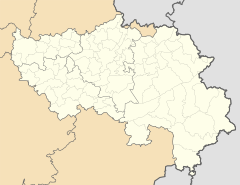Braunlauf
| Braunlauf | ||
|---|---|---|
|
|
||
| State : |
|
|
| Region : | Wallonia | |
| Province : | Liege | |
| District : | Verviers | |
| Coordinates : | 50 ° 15 ′ N , 6 ° 3 ′ E | |
| Residents: | 230 pop. | |
| Height: | 460 m | |
Braunlauf is a village in the German-speaking Community in Belgium with around 230 inhabitants, which belongs to the municipality of Burg-Reuland .
geography
Braunlauf is located in the northwest of the municipality of Burg-Reuland, northeast of Maldingen and south of Weisten . The city of Sankt Vith is about 6 kilometers northeast. The Braunlauf stream , a right tributary of the Our, flows through the village in an easterly direction . To the south of the village is the Hochtumsknopf , a mountain with an Iron Age barrow that was discovered in 1825 and in which shards, bones, ashes and an iron container were found.
history
The place is probably of Celtic origin; the oldest place name is given as Brunefa or Brunafa . In 1704 the Archbishop of Cologne and Prince-Bishop of Liège, Joseph Clemens of Bavaria, approved the construction of a chapel. In 1898 the chapel was restored and a sacristy was added. The new chapel dedicated to St. Joseph is a building with a separate bell tower and built according to plans by the architect Maurice Robert from Gouvy . It was inaugurated in March 1966 by the Liège bishop Guillaume-Marie van Zuylen .
education
In Braunlauf there is the smallest school in East Belgium with 16 pupils, a one-class school in which children between the ages of three and 10 are taught.
Individual evidence
- ↑ Information about Braunlauf. Website of the municipality of Burg-Reuland
- ↑ Grenz-Echo : A visit to the smallest school in East Belgium Issue 23 March 2018 (only with subscription)
- ^ Community school Braunlauf - Burg-Reuland, Belgium - primary school In: gemeindeschulebraunlauf.be , accessed on December 8, 2018.

